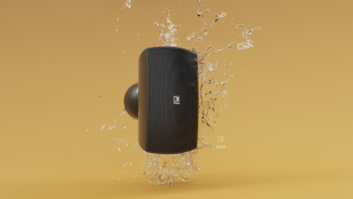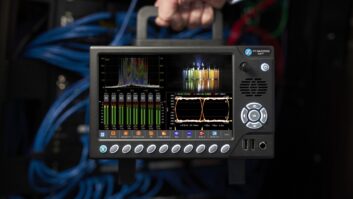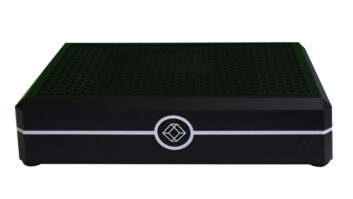High-Tech Ministry
Mar 1, 2003 12:00 PM,
By Mike Lethby
The city of Alpharetta, Georgia, proudly traces its origins back to a tiny village named New Prospect Camp Ground, established alongside a Cherokee Indian trail from the North Georgia Mountains to the Chattahoochee River. Growing over the years into a trading post where native Americans and white settlers exchanged their goods, the surrounding countryside proved to be excellent farming land, especially for cotton. On December 11, 1857, the town was chartered, becoming the county seat of Milton County, and was renamed Alpharetta from the Greek words alpha (first) and retta (town). Today it’s a prosperous northern neighbor of Atlanta with a largely affluent, professional community.
In 1996 a new nondenominational church was founded to serve the city, temporarily holding its services in the setting of a local convention center. A year later, plans for a permanent facility were under development, and with a sophisticated, tech-savvy community on its doorstep, the church leaders recognized that an equally sophisticated, high-quality approach to sound reinforcement with video enhancement would be a vital part of the game plan.
By this point, the church had amassed some 1,600 regular attendees, and the plan called for a fairly large worship hall, seating 3,000. This facility would then be expanded with the addition of four more rooms, a prescient move, because the church’s congregation has already blossomed to 10,000 attendees.
One of the church’s pastors knew of the work of system designer and integrator Clark ProMedia — based in Cumming, Georgia — and called in the firm’s head of engineering, George Clark, to assess the acoustic challenge of the initial (East) hall and to propose solutions. Clark ProMedia provides custom design and build media solutions, including sound reinforcement systems, multimedia applications, along with acoustic design and architectural rendering services, and specializes in systems for houses of worship.
The company provides clients with “single-source accountability” on a project from concept through implementation and postimplementation servicing. Services include consultancy to a client’s architect, assisting in room shaping and infrastructure acoustic design, and making recommendations regarding HVAC and mechanical noise isolation. Design services include a completed EASE model, CAD, and Stardraw.com schematics, and implementations include sound reinforcement, acoustic, multimedia and theatrical lighting design, and complete design services for the creation of a full acoustic model for a room.
Based on early discussions, Clark ProMedia was awarded the project management contract to design and engineer the installation and to provide acoustic analysis and construction consultancy, with company founder George Clark himself supervising the whole project.
Clark recalls: “The church’s worship style is definitely contemporary, very much in the rock ‘n’ roll style, with guitars, bass, drums, Hammond B-3, electronic keyboards, and vocals. Because of that, they made a conscious decision not to invest heavily in the physical characteristics of the first auditorium, the East Hall, but to keep it quite simple, like a large warehouse measuring 130 by 200 feet with a 35-foot ceiling. There are exposed steel ceiling girders, too, so the challenge was to take this minimalist physical space and turn it into an acoustically perfect hall with solid acoustic properties for everything from rock ‘n’ roll to the spoken word. The native RT in the room was six-plus seconds to begin with; you might as well have been in a cave. If you weren’t facing the person you were trying to talk to within three feet, it was difficult to understand what they were saying.”
A room model was built in EASE 3.0 from plans provided by architect Niles Bolton Associates. All design considerations were assessed, and loudspeaker placements were modeled.
“EASE highlighted the fact that we had long RTs,” says partner Matt Card. “And using the ray-tracing function, we saw that there was significant flutter echo in the room. It also helped us determine that to ensure even subwoofer coverage, the subs would need to be configured as line arrays stage left and right, which is an unusual solution; you don’t normally see flown subwoofer line arrays.”
Acoustic treatment in the East Hall consisted of a combination of panels for absorption and diffusion, using 2-inch wall panels and 2-inch-thick lightweight fiberglass ceiling lapendary. Matters were simpler in the West Hall, where Clark was able to influence the wall surface design at the drawing-board stage.
“Our objective was to bring the RT down to less than 1.1 to 1.2 seconds and to use a loudspeaker system that could be focused precisely,” Card says. “What became central to the issue of tuning the acoustics of the room was finding loudspeakers that were truly arrayable and of professional touring concert quality.”
In addition to the sophisticated audio system in the large East and West Halls, an impressive video system was designed for both taping and live presentation enhancement.
Clark ProMedia had taken on a project that would challenge all its technical resources and create a landmark in church worship technology.
ACOUSTIC SOLUTIONS
The first step was to analyze the nature of the room using EASE software, which provided Clark with the fine detail needed to design the array configurations and determine optimal loudspeaker locations.
This proved that the experience of his own ears was intuitively correct: a combination of careful acoustic treatment of the hall’s surfaces and underlying building structures with appropriate sound reinforcement technologies would deliver the results the church was looking for.
After the initial EASE analysis, Clark recommended Renkus-Heinz as the primary loudspeaker solution, supplied by Scott Hough, the Renkus-Heinz representative at Griffith Sales Associates of Duluth. A package of complementary, high-value technologies and products were also specified to support the system as the specification grew to accommodate the extra halls. These names have expanded to include Soundcraft consoles, Crown amplification, BSS Audio Soundweb audio distribution and Ashly Audio equalizers, and Drawmer, PreSonus, and Klark Teknik processing.
“Renkus-Heinz worked with us very closely on this, and the crucial difference its products made for us was that they really arrayed correctly while also providing smooth horizontal coverage,” Clark says. “Their TrAP [True Array Principle] design means there are no strange gaps between boxes, and that makes it easy to get even sound coverage throughout a room. We wanted to make the coverage even under the balcony, at the back, in the center, and at the front: we were aiming for extremely smooth and even coverage across the whole spectrum of this room. They’ve got a certain set of characteristics: smooth and bright sound with no harshness and excellent arrayability, which allows them to achieve a really tight point-source pack.”
When it came to designing the church’s second hall, the West Auditorium, Clark ProMedia was involved throughout the design and build process in developing audio and video solutions. “We had the ability to influence the shape and materials of the walls,” says George Clark, “and we specified that a diffusion cinder block be built into the wall construction design to provide sound absorption and diffusion characteristics.”
The diffusion cinder block contains internal cavities, which places a 1-inch fiberglass core within each 12-by-16-inch concrete wall block. These large-scale load-bearing prefabricated cement blocks, made by RPG Diffusor Systems (see the sidebar “The DiffusorBlox”), form the primary wall construction and combine specific reflective and diffusion properties. “They change the acoustics of the room dramatically,” says Clark. “The benefit to the builder is that instead of regular cement blocks with no acoustical properties whatsoever, which then need lots of acoustic treatment, this block has precise diffusion and absorption characteristics built in, which means we have been able to save the church a significant amount of money on acoustic treatment in that space.”
SYSTEM SPECIFICS
For the East Room, which seats 3,000 including the balcony, Clark specified three three-wide Renkus-Heinz TrAP40 clusters and three SR62H downfills hung below, and five two-wide TrAP Juniors with one TRC121 downfill to provide delays, with eight TRC51 under-balcony delays. To round out the loudspeaker system, Clark used eight OAP TR218 subwoofers, positioned in vertical line arrays stage left and stage right.
Stage monitoring is accomplished by MR121, MR5, TRC121, and TRC151D loudspeakers, and the whole system is controlled by Renkus-Heinz X12, X14, and X24 processors.
The West Auditorium was intentionally designed as a more acoustically live space than the East Hall: “We wanted it to have more of a ‘gymnasium’ feel, with an RT of about 1.3 seconds,” says Clark, “and again we modeled it in EASE to get the specifics precise.”
The consoles there are the same as those installed in the East Hall: a 56-channel Soundcraft Series 5 and a 56-channel SM20 monitor desk, with signal processing handled by Drawmer compressors, limiters, and gates.
The West Auditorium mirrors the East Hall’s system with three three-wide CT7215 clusters, accompanied by three SR62H downfill loudspeakers, one per cluster, and two two-wide TrAP Junior arrays and two three-wide TrAP Junior arrays for delays. The stage monitor system features eight TRC121 cabinets and eight dual 18-inch subwoofers. There are also three Renkus-Heinz D26 digital loudspeaker controllers handling loudspeaker processing functions, a BSS Soundweb system that provides delay timings and audio distribution, and BSS equalization. Amplifiers are Crown MP1200 and MT2400 models, with MA5000s driving the subwoofers, which once again are eight OAP TR218 subwoofers, positioned in vertical line arrays stage left and stage right.
The D26 controllers, with two inputs and six outputs, provide both loudspeaker-specific processing and system integration functions, with multiband parametric EQ, limiting, and delay on inputs and outputs as well as complex crossovers with limiters, EQ, and time-alignment delay on each frequency band. The D26 can be controlled through MIDI from within SIA Software Smaart Pro’s equalization window; that allows the operator to view both the equalization and the measurement microphone at the same time.
Clark’s patching systems have been designed to maximize the system’s flexibility, says Card. “One of our design philosophies is not only to make a system sonically pure but also easy to operate,” he says. “Patching systems can be nightmares, and one of the most interesting things on this installation is our proprietary patch bay design, which allows for easy manipulation; you can change mixes at the switch of a cable. It’s not exactly magic, but it’s certainly very simple to use.”
VIDEO COMPLETES THE PICTURE
An important part of any installation of this type and magnitude is the making sure that all members in the congregation can hear every word and also see every image. Fortunately, the North Point church community is blessed to have a large number of technology-literate members who were supportive in the efforts to specify and install a rather elaborate video solution.
In the East Auditorium, there are two wallmounted 10-foot-by-14-foot Da-Lite Da-Tex side screens, which each receive a rear-projected image from a Barco 5,000-lumens output DLP projector. In the room, there are two fixed cameras and one mobile camera, which are used during every service, with expansion capability for as many as three mobile cameras on the stage area for certain events. All cameras feed directly to a fully equipped video production control suite via fiber-optic link. In the suite, a producer directs the service and selects the camera shots that are then fed to the Barco projectors.
Although the live cameras are used primarily for in-house image distribution, all cameras and microphones also feed into their on-location recording studio — a complete 5.1 environment designed to record the services and other programs for distribution to their satellite church “campuses” and for publication of their DVD sermon series, as part of the church’s outreach ministry.
THE VIRTUAL PASTOR
In the West Auditorium, which is effectively a mirror image of the East, there is an identical dual-screen installation. But the experience in this room is a little different. Because the church runs simultaneous services and the pastor obviously can’t teach from both rooms at the same time, Clark’s team has developed a system that is both technologically stunning in its visual effect and cost effective compared with building a whole new church. Both rooms have local “praise teams” (music ministry), but when it’s time for teaching, an 18-foot-by-26-foot custom Stewart screen (16:9 aspect) drops down from the ceiling. Back in the East Auditorium is a rare NASA-specified, Panasonic serial digital interface (SDI) high-definition camera. How the camera was acquired is an interesting story in itself, but suffice to say, this congregation is well connected and knows its technology.
The high-definition camera takes a static shot of the pastor onstage, which is then broadcast by fiber-optic link to the studio into an SDI switcher and then directly to a 12,000-lumens-output projector. Although that is stunning, to say the least, the church plans in the near future to upgrade to a new Christie Roadster S9 high-brightness DLP projector. Even though the new Roadster S9 is rated at “only” 8,500 lumens, it uses Texas Instruments‘ three-chip 0.9-inch DLP system featuring its new Dark Metal Process, which significantly increases contrast ratio to an outstanding 400:1 ANSI or 800:1 full field, delivering superior video image reproduction.
The effect of this exceptional high-definition capture, combined with theatrical stage lighting design and projected with high-output digital projection of this quality, creates the effect of what has been described as a holographic image, affectionately referred to by church member and Clark ProMedia’s team as the Virtual Pastor. “There is an almost three-dimensionality quality to the image,” Card says, “to such a degree that we have heard the comment on more than one occasion, ‘You know, I forgot I was watching an image on a screen; I thought it was live.’”
AROUND THE CAMPUS
There are three other rooms on campus, which also feature an impressive array of audio and video equipment. The Attic, intended primarily for use by students aged 14 through 20, is a 500-seat venue with an in-the-round stage that is designed to have the feel of a blues nightclub and stages performances by national Christian recording acts. The KidStuf Theater, with more than 1,000 seats, hosts children’s services. Designed with a Disney-meets-Nickelodeon look and feel, services are dramatized, and scripted performances take the children through different vignettes and scenarios. Finally, there is the Warehouse, a small room for preschool-age children.
UP AND RUNNING
Now that the systems are in day-to-day operation, Clark and Card reflect on the project’s completion. “It was clear from the day that we first met the North Point team in 1997 that this project would represent a unique set of opportunities,” says Card. “The North Point team embodied a vision that looked to change how the average person views the contemporary church. In its goal to make the church increasingly relevant and meaningful in today’s MTV and cineplex society, the team knew that music and technology would be vital to its mission. The church has been blessed with extremely talented and artistic worship teams that exceptionally deliver on the church’s goal of being relevant through song and music.”
Adds Clark: “Clark ProMedia’s job is to bring all of our creativity and talent to bear and create a performance environment that rivals the best that is found in secular performance venues while is simple enough for laypeople to operate. We have been fortunate to be able to establish a partnership with a church that values technical excellence as an integral part of the worship experience. North Point Community Church has set a new standard for the role of technology in worship, and Clark ProMedia has been honored to be a piece of that over the last five years.”
Al Scott, production director for North Point Community Church, has the last word: “Being relevant is key to the NPCC strategy. We take the best of what secular culture offers and use it to communicate our message. In building, maintaining, and utilizing our performance systems, we make the most of performance technology. In addition to church activities, our facilities are used by the community at large for a variety of events. In each case, sound reinforcement is vital to the success of the event. Given the nature of our services, flexibility is important, but it is essential that the system must remain easy to operate, because it is run by volunteers. What has impressed us most about these solutions is that these systems can sound and perform so well yet be so manageable. Clark ProMedia has partnered with us in providing quality systems that have both met and exceeded expectations.”
Mike Lethby is cofounder of Gasoline Media and is an experienced journalist, editor, photographer, and event organizer. He can be reached at [email protected].
The DiffusorBlox
RPG Diffusor Systems’ DiffusorBlox provide both an architectural building material and acoustic treatment in one step. The blocks were used extensively in the West Auditorium. Although the cost per block may be close to double that of ordinary cinder block materials, its acoustic properties result in significant cost savings, because acoustic problems can be addressed and avoided during the building phase. The blocks’ special slotted design creates Helmholtz resonator chambers, as well as the phase-grating pressure gradient absorption mechanism to provide 100 percent absorption at 100 Hz. DiffusorBlox simultaneously offer a distinctive appearance, extended low-frequency absorption, sound isolation, and sound diffusive reflection control. Slotted and unfinished, stained or lightly painted DiffusorBlox have a Noise Reduction Coefficient (NRC) of 0.85. Nonslotted and unfinished, stained or lightly painted DiffusorBlox have an NRC of 0.75. Slotted and fully sealed DiffusorBlox have an NRC of 0.41. Nonslotted and fully sealed DiffusorBlox have an NRC of 0.40.
For More Information
Ashly Audio
www.ashly.com
Ž 236
Barco
www.barco.com
Ž 237
BSS Audio
www.bss.co.uk
Ž 238
Christie Digital Systems
www.christiedigital.com
Ž 239
Crown
www.crownaudio.com
Ž 240
Da-Lite
www.da-lite.com
Ž 241
Drawmerwww.drawmer.com
Ž 242
Klark Teknik
www.klarkteknik.com
Ž 243
Panasonic
www.panasonic.com
Ž 244
PreSonus
www.presonus.com
Ž 245
Renkus-Heinz
www.renkus-heinz.com
Ž 246
RPG Diffusor Systems
www.rpginc.com
Ž 247
SIA Software Company
www.siasoft.com
Ž 248
Soundcraft
www.soundcraft.com
Ž 249
Stardraw.com
www.stardraw.com
Ž 250
Stewart Filmscreen
www.stewartfilm.com
Ž 251
Texas Instruments
www.ti.com
Ž 252
Ž Circle this number on Reader Service Card or visit freeproductinfo.net/svc







